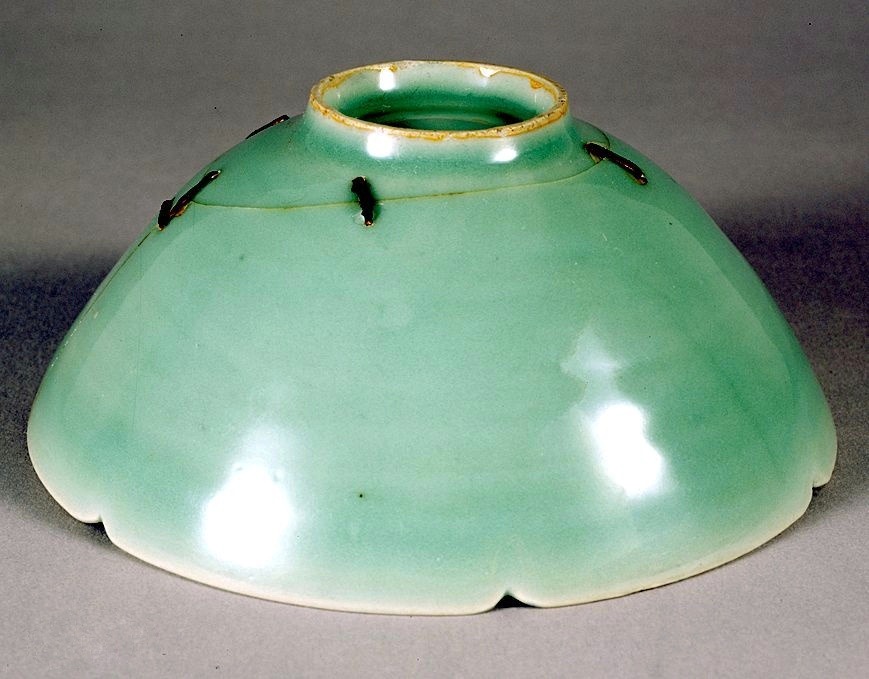Repairing things has become a fashion today. Especially, the Japanese art of repairing broken ceramic and pottery called Kintsugi (金継ぎ), or Kintsukuroi (金繕い) has gained fascinating popularity. The basic process of Kintsugi is to fill up and glue the cracks of the broken object using varnish, and then cover the varnish with lacquer mixed with powdered gold. Each repaired object has a unique golden pattern, shows the beauty of imperfection praised by the Japanese.
According to a legend, the rise of Kintsugi in Japan all started with a metal stapled Chinese celadon bowl, which was sent back by a Japanese ruler to China for replacement. Instead of a new bowl, he got returned a metal stapled bowl. In this post, we’ll discuss the legend in great detail. But let’s first introduce the Chinese stapling method of ‘Juci’.
Juci: Staple Method of Fixing Broken Ceramics
There is a harder way to fix broken ceramics called Juci (Chinese: 锔瓷), meaning to pin the broken pieces of ceramics back together with staple-like metal. Both the inner and outer walls need to be treated so to make the object look good and work properly after the repair. The process goes like this: observing, positioning broken pieces, drilling holes for the nails, putting the nails in, polishing. The hardest parts are drilling and nailing. The whole process requires precision, patience and solid skills.
Celadon Glazed Tea Bowl in the Tokyo National Museum
One of the most famous repaired piece using this technique is now in the Tokyo National Museum, which is this celadon-glazed tea bowl from the Southern Song Dynasty. This is in fact the bowl that we’re going to discuss in the Legend later in this article.
The celadon glaze colour is pure and elegant like icy jade, the firing technology represents the highest level of the Longquan kiln. The crack at the bottom along with the nails add a unique kind of wild beauty to it. It also has a special name: leech nail tie (蚂蝗绊), came from the leech-like pins that mended the crack. The legendary story behind the bowl is even more fascinating.

The Legend Behind The Bowl
An article from the Edo Period in Japan, called “A Book of Tea by Leechu,” states: “In the early years of Anyuan (around 1175A.D.), military commander Taira no Shigemori donated gold to the Yuwang Mountain of the Song Dynasty’s China. The master monk of the mountain Fozhao gave this tea bowl to Taira no Shigemori in return.”
As the eldest son of the Taira clan – one of the four most powerful clans in Japan at the time, Taira no Shigemor’s image is that of a gentle and calm all-rounder. He was a buddhis. At that time, Buddhists in Japan and China believe in karma, they would do more good deeds so that they would have happiness in afterlife. During the Spring Festival in ancient China, the rich people would ask their servants to secretly put pieces of silver wrapped in paper on the windowsill of the poor people, which was also a practice of accumulating virtues. In order to accumulate more virtues so that his descendants could be blessed, Taira no Shigemor decided to plant some good roots abroad, in China specifically.

Taira no Shigemor found a ship owner with a reputation for honesty and prepared 3,500 liangs of gold (1 liang = 37.3 grams). He told the ship owner to keep 500 liangs as the reward of shipping the rest 3,000 liangs to China, of which 1,000 liangs would be presented to the monks of Yuwang Mountain and 2,000 to the emperor of China.
The ship owner arrived China successfully and made the donation to the monks and the emperor. The Chinese emperor at the time Zhao Shen was moved and granted equivalent of 500 hectares of land to Yuwang Mountain in the name of Taira. And the Longquan kiln celadon tea bowl was sent back to Taira no Shigemor as a gift.
Donating gold abroad showed that the Taira clan was powerful and influencial. The rise of the Taira clan intensified the conflicts with another clan, the Minamoto clan, which eventually led to a civil war, known as the Genpei War, which ended in failure for Taira clan.
The bowl was passed around families in Japan. More than 200 years later it became the collection of Shogun Ashikaga Yoshimasa (8th ruler of the Muromachi period). But the bottom has cracked. He asked the envoy to China to bring the bowl to China. He hoped that the Chinese emperor Yongle of the Ming Dynasty could change it to an undamaged bowl with the same style and quality.
But from the Southern Song dynasty to the Ming Dynasty, the style of celadon had changed and it was impossible to get the same thing again. The emperor Yongle had to ask a craftsman to perform the Juci repairing method and sent the repaired bowl back. The nails that mended the crack were thin on both ends and thick in the middle, just like the shape of leech, so it was called leech nail tie.

Sure it was not perfect, but imperfect beauty has always been aesthetically praised in Japan. Since then the evaluation of this bowl is higher and higher. After collected by several other historical figures, in the 1970s, this tea bowl finally found its place in the Tokyo National Museum. The history of the bowl is more valuable than the object itself. There’s a lesson for us to learn: embrace the imperfection and appreciate beauty in every unique feature in things and in life.
Discover more from Hello Tea Cup
Subscribe to get the latest posts sent to your email.



No Comments